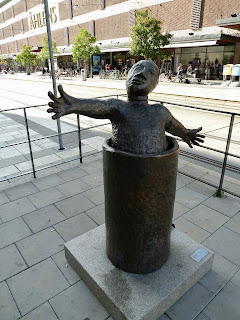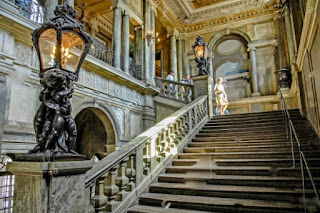7th Sept 2020
 |
| Farewell Sweeeden. |
7th Sept 2020
 |
| Farewell Sweeeden. |
 |
| The front of the Royal Palace (before present building works) |
Entry cost 180 Krone, and there were several floors open to the public. I was here for ages but will only bore you with a small selection of pics.
 Right: The Grand Staircase, or one of them...there were several.
Right: The Grand Staircase, or one of them...there were several.
Left: The decadent Karl X1 gallery, inspired by the Versailles' Hall of Mirrors.
Right: A showcase displaying all the Swedish 'Orders of Whathaveyou'. The Premier Order is the Order of the Seraphim.
Left: Queen Kristina's silver throne in the Hall of State. It is indeed made of solid silver. I'm surprised Anders Zorn (see previous blog) didn't get one. Maybe he did!
The rest of the Hall of State was given over to a large display of ancient and modern rugs. Rugs! Rather boring in my opinion.
Left: This gallery is used as the State Dining Room for 'formal' Dinners.
Right: The table set for supper. They probably borrowed the silverware from Anders Zorn!
Right: I was told this 'commode' was made in Russia and is famous and extremely valuable. I thought a commode was where you relieved yourself if you were a bit wonky and couldn't get to the loo.
Left: There were lots of fine uniforms on display. Mostly worn by various 'Gustavs' I expect.
Right: The Royal Bedchamber. Prince Charles and Camilla kipped here when on a state visit a year ago. It doesn't look very cosy, but I was told it is laid out rather differently when they have guests staying.
While in this room I bumped into a charming lady guide who gave me a full run-down on the Swedish Royal history. I couldn't stop her waxing lyrical for about 40 mins. As I failed to make notes I have forgotten most of the details but it involved lots of Gustavs (Gustav 111 shot in 1792 at a fancy dress ball...probably, big mistake, went as a deer), Napoleon and a rather Machiavellian chap called Jean-Baptiste Bernadotte who was a French General and adviser/mate of Napoleon who went on to become King of Sweden. He sounded rather like the Napoleonic version of Dominic Cummings. You can look it all up on Wikipedia if interested.
There were lots more rooms, stately halls and exhibits, but I think that is enough to send you to sleep. I missed out on the Museum of Tre Konor (13th century fixtures and fittings), the Royal Treasury and Gustav 111's Antikmuseum.
Next on into the Royal Armoury which is housed in a large cellar beneath the Palace...and free entry! Can't think why as all other museums seem to charge the earth, but I wasn't complaining. This is divided into two. One half devoted to uniforms throughout the ages and the other to Royal carriages;
3rd - 4th Sept 2020
 |
| The big Dala Horse (Dalahäst) in Mora. |
It was a 30 minute train ride from Tällberg to Mora at the northern end of Lake Siljan. There are two railway stations in Mora, and I got off at the main one which was, irritatingly, much further from where I was to stay than the other one. I had booked in to a guest house on the west side of town. A one mile walk. They are a very trusting people, the Swedes. I was the only guest and was texted with the codes to get into the front door and for the room key cabinet. The house was impeccably clean with a fully equipped kitchen, sitting room and bedrooms. Effectively I just helped myself and was never visited by the owners; I simply put the key back in the cabinet when I left. For all they knew I could have been hosting a wild drug-fuelled orgy, trashed the place, nicked all the kit and done a runner....which, of course, I didn't.
Left: A smaller Dalahäst. They come in all sizes (2" up to the 40' job featured at the top) and the region (Dalarna is famous for these originating from before the 17th century). They are emblematic of Sweden and popular souvenirs. They are often given to visiting dignitaries whom I'm sure are very grateful.
The town is famous for the revolutionary Gustav Vasa who, in 1520, arrived here and stood in front of the local population to try to whip up a rebellion against the ruling Danish regime. The locals booed him and 'gave him the finger' (they had probably been on the pop, for which, until a recent clampdown, the Swedes were famous). He was forced to do a runner (on skis) to the border.
After he left, and the town had sobered up, they reconsidered and a couple of locals set off in pursuit of him and finally overtook him in Sälen, 90km away, brought him back and he, and they, saw off the Danes and changed Swedish history. He became King Gustav 1. Right: His statue standing where he addressed his, initially, bolshy countrymen..
 This led to another event for which Mora is famous; the Vasaloppet ski race which is held on the first Sunday in March. It has attracted up to 15,000 competitors for the 90 km race from Sälen to Mora.
This led to another event for which Mora is famous; the Vasaloppet ski race which is held on the first Sunday in March. It has attracted up to 15,000 competitors for the 90 km race from Sälen to Mora.
Left: The finish line in Mora.
Right: Not my photo of course, but a snap of the skiiers in the fiercely competitive race.
 Left: Behind which is the Vasaloppsmuseet (museum) which I was hoping to visit. It was closed. Probably due to lack of tourists. What a bugger, and I don't know what was on display. Lots of skiis, bobble hats and photos presumably.
Left: Behind which is the Vasaloppsmuseet (museum) which I was hoping to visit. It was closed. Probably due to lack of tourists. What a bugger, and I don't know what was on display. Lots of skiis, bobble hats and photos presumably.
